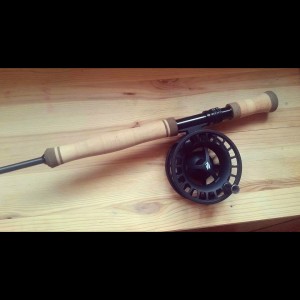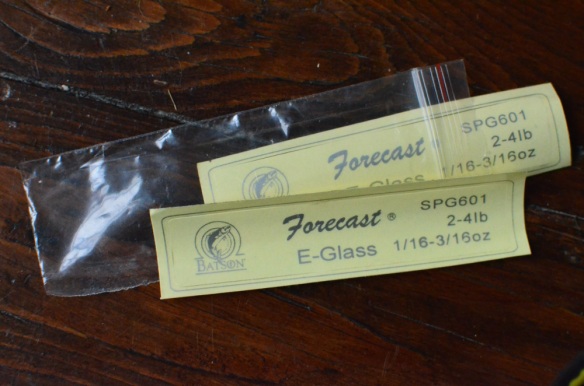The finish of my REV 9010-4 had barely cured when a freight train of work hit me. A week later, I packed it without having tested it… My first stop in the road to Ireland was in Beauvais. It’s a rather uninteresting small town, but you’ll find there (a) cheap planes for Shannon ; (b) Ed. Ed is my dear friend, and the closest thing I know to a perfect fishing buddy. Simple, fun, kind, very competent with a rod, at ease with beers and whiskies… Paying him a visit is always a joy for me. He knows my obsession with casting and is more than willing to oblige. So the night I got to his place, we hit the lawn for a first test.
the lawn
We were testing the REV 9010 paired with two combos: a Sage 2210 with a RIO Depthfinder 400 gr.; my old’n trusty Okuma Airframe 7/9 with an older 9wt Aircell Supreme which will simply not die. I love this last one, it flies like a champ. I like to underline a rod, I think it’s a good test on its ability to convey information.
On the lawn, things are easy. There’s no trees to bother you, you don’t have a friend just where the line is supposed to fly, the ground is not moving with the waves or with said friend casting frenzy. No snags for the line lying on the ground. And even if my casting fly for such rods has some bulk, it’s nothing compared to a pike streamer. I take out 20m of the Depthfinder,
make a false cast to take the head out of the tip guide, shoot… dang. That’s the sound of the line straighteneing out. Massively overpowered, the line’s end lands at a familiar left hand 90° angle. Well, I think. This is going to be fun. I take the whole line out, with a good meter or so of orange backing hanging out of the reel and I proceed to go berzerk. Second cast, there’s easily ten meters of running line out of the tip when I try to shoot. I land a pile of crap in front of me… Damn sinking heads!
Then I remember Marc-sensei severe frown. I take back most of the line, and focus on proper loop shape at 12m. The rod reacts rather well at short distance, despite the fact I’m basically casting lead core. Not pleasant, but it remembers me the mechanics of fly casting, and the motto:
l e s s p o w e r !
A dozen of short casts later, I’m back to distance. Take the head out. But not to much. Smooth application of power. Get speed, but no jerk. First try, most of the line is out. Second try, remember to reach far back for the frontcast haul. Zwooof-tak! Backing. I feel a rush of stupid teenager thrill&pride…
Many casts later Ed and I are getting the backing out of the tip guide. What I like most? Very low tip bounce. The loop zooms out without ugly rod-leg waves. I’m thinking: this is gonna work well on the pikes.
The rod is heavy (it’s a 10wt), and so is the line. Those ultra fast sinking things are not made for anything delicate. But with a nice, controlled double haul, you will reach out to that border over there with little fatigue. A side note: the Sage 2210 I’m using with the rod is just perfect for the job: the rod balances just shy of the grip’s end, the drag is great (doesn’t matter much for pike, but could come handy the hypothetic day I’ll find myself on the flats chasing tarpons).
let’s fish
A short week on the lakes around Corofin, Co Clare, Ireland, taught me what I didn’t know already about the REV 9010-4. Let’s break it down in three points:
- the rod is a casting machine. It really works well. And I’m talking about huge streamers in strong head winds. Ireland did its thing on us: gales, hail, pouring rain, bright sun, soft grays, we had it all. There’s more power than you need in the blank’s butt to punch a super heavy line and half a chicken through aggressive guts of wind. And as far as I can judge it, it will make things easy for you: it’s not the kind of rod that require concentration to operate it properly.
- the rod fights well. I caught 10 pikes on the REV 9010-4 during this trip. Modest count, but enough to draw some conclusions. With 1.20 m of 80% fluoro as a leader, I did not bother with finesse. Strike. Lock the line. Let the rod work. It’s a very fun way to fight. I guess a really big fish would have forced me to use the reel, but we’ve had no luck with that. Anyway: superb rod behaviour under heavy load.
- the rod is not tiring. of course it’s heavy, but is it heavy for a 10wt? A Sage Musky is 145g, this one is 172g. But the grip design (very big fighting butt and relatively heavy seat) and the huge stripers accounts for most of the difference. It feels a tad heavier in swing weight than the super champs of the category. But just a tad. You can wave it all day during several day. I did it. It will leave your arm sore after 10 hours, but I’m yet to see a rod that won’t. It’s not sight fishing, with all the wait and rest. It’s fishing the borders, cast after cast after cast, all day long. And if you’re not fit and well warmed up (I’m neither) you’ll pay. But I really cannot imagine much harder work with a flyrod, and this rod impressed me. The last day, I still was eager to grab it.





























